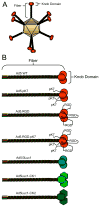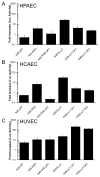Enhanced Gene Delivery to Human Primary Endothelial Cells Using Tropism-Modified Adenovirus Vectors
- PMID: 19834585
- PMCID: PMC2761693
- DOI: 10.2174/1875037000801010007
Enhanced Gene Delivery to Human Primary Endothelial Cells Using Tropism-Modified Adenovirus Vectors
Abstract
Endothelial cells have been noted to have relatively low expression of the native receptor for adenovirus serotype 5 (Ad5), coxsackie and adenovirus receptor (CAR), and are thus refractory to Ad5 infection. In this study, we hypothesize that increases in the infectivity of Ad5 in primary human pulmonary artery (HPAEC), coronary artery (HCAEC) and umbilical vein endothelial cells (HUVEC) can be achieved through genetic capsid modification of Ad5 to bypass CAR-dependent infection. The modifications tested in this study include incorporation of an integrin-binding RGD peptide motif (Ad5.RGD), a poly-lysine motif (Ad5.pK7), a combination of both of these peptide domains (Ad5.RGD.pK7), an adenovirus serotype 3 knob domain (Ad5/3Luc1) and canine adenovirus serotype 1 or 2 knob domains (Ad5Luc1-CK1 and Ad5Luc1-CK2). In HPAEC and HCAEC, the greatest infectivity enhancements were achieved using Ad5/3Luc1 (26-fold and 30-fold respectively). HUVEC was most readily infected by Ad5Luc1-CK1 (213-fold). These results demonstrate that gains in Ad5 infectivity in endothelial cells can be accomplished with genetic capsid modifications.
Conflict of interest statement
The authors have no conflicts of interest.
Figures



Similar articles
-
A human adenoviral vector with a chimeric fiber from canine adenovirus type 1 results in novel expanded tropism for cancer gene therapy.Gene Ther. 2005 Dec;12(23):1696-706. doi: 10.1038/sj.gt.3302588. Gene Ther. 2005. PMID: 16034451
-
Enhanced adenovirus infection of melanoma cells by fiber-modification: incorporation of RGD peptide or Ad5/3 chimerism.Cancer Biol Ther. 2003 Sep-Oct;2(5):511-5. doi: 10.4161/cbt.2.5.440. Cancer Biol Ther. 2003. PMID: 14614316
-
Tropism and transduction of oncolytic adenovirus 5 vectors in cancer therapy: Focus on fiber chimerism and mosaicism, hexon and pIX.Virus Res. 2018 Sep 15;257:40-51. doi: 10.1016/j.virusres.2018.08.012. Epub 2018 Aug 17. Virus Res. 2018. PMID: 30125593 Review.
-
Double modification of adenovirus fiber with RGD and polylysine motifs improves coxsackievirus-adenovirus receptor-independent gene transfer efficiency.Hum Gene Ther. 2002 Sep 1;13(13):1647-53. doi: 10.1089/10430340260201734. Hum Gene Ther. 2002. PMID: 12228019
-
A novel fiber chimeric conditionally replicative adenovirus-Ad5/F35 for tumor therapy.Cancer Biol Ther. 2017 Nov 2;18(11):833-840. doi: 10.1080/15384047.2017.1395115. Epub 2017 Nov 16. Cancer Biol Ther. 2017. PMID: 29144842 Free PMC article. Review.
Cited by
-
Transcriptional targeting of primary and metastatic tumor neovasculature by an adenoviral type 5 roundabout4 vector in mice.PLoS One. 2013 Dec 23;8(12):e83933. doi: 10.1371/journal.pone.0083933. eCollection 2013. PLoS One. 2013. PMID: 24376772 Free PMC article.
-
Biodistribution and inflammatory profiles of novel penton and hexon double-mutant serotype 5 adenoviruses.J Control Release. 2012 Dec 28;164(3):394-402. doi: 10.1016/j.jconrel.2012.05.025. Epub 2012 May 22. J Control Release. 2012. PMID: 22626939 Free PMC article.
-
Genetic Delivery and Gene Therapy in Pulmonary Hypertension.Int J Mol Sci. 2021 Jan 25;22(3):1179. doi: 10.3390/ijms22031179. Int J Mol Sci. 2021. PMID: 33503992 Free PMC article. Review.
-
Magnetic nanoparticles enhance adenovirus transduction in vitro and in vivo.Pharm Res. 2012 May;29(5):1203-18. doi: 10.1007/s11095-011-0629-9. Epub 2011 Dec 7. Pharm Res. 2012. PMID: 22146803
-
Retargeting of gene expression using endothelium specific hexon modified adenoviral vector.Virology. 2013 Dec;447(1-2):312-25. doi: 10.1016/j.virol.2013.09.020. Epub 2013 Oct 15. Virology. 2013. PMID: 24210128 Free PMC article.
References
Grants and funding
LinkOut - more resources
Full Text Sources
Other Literature Sources
Research Materials
